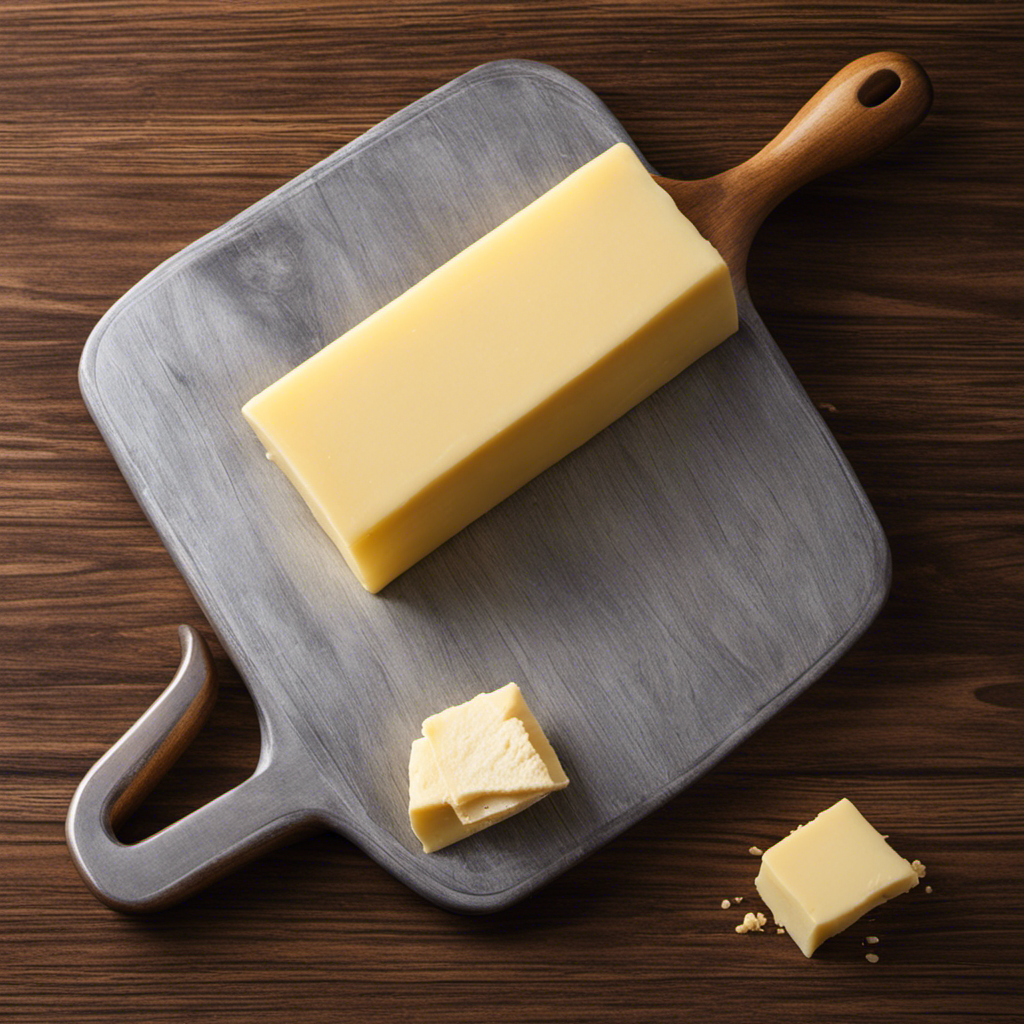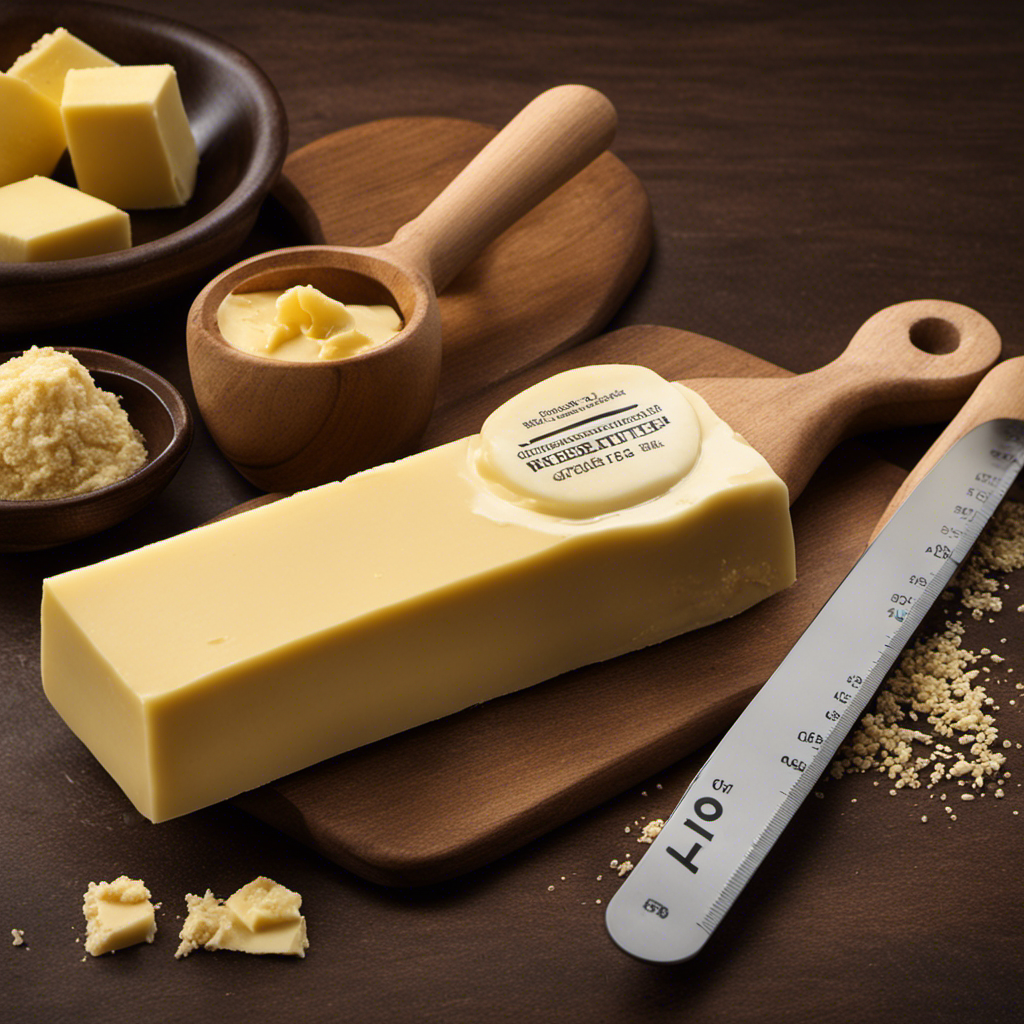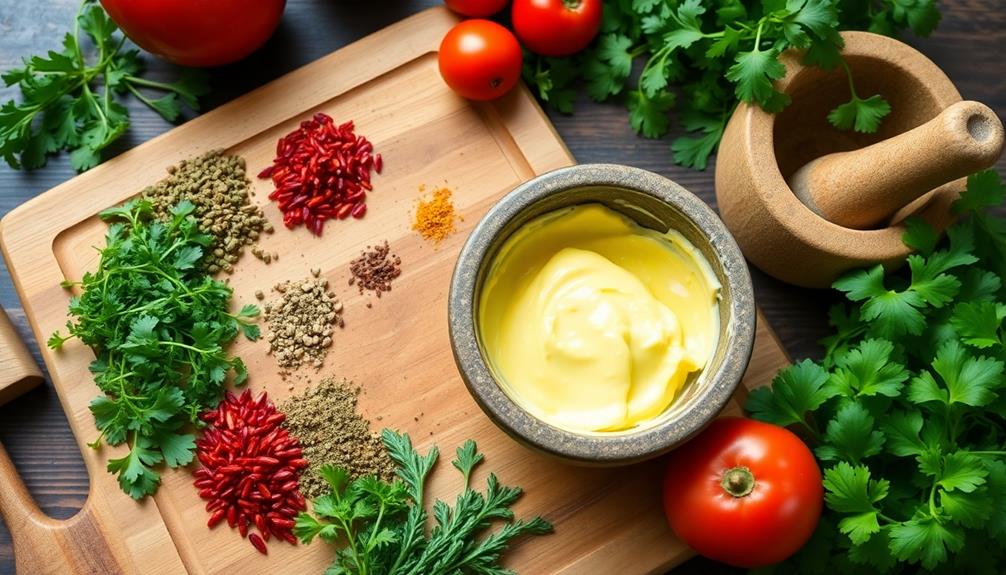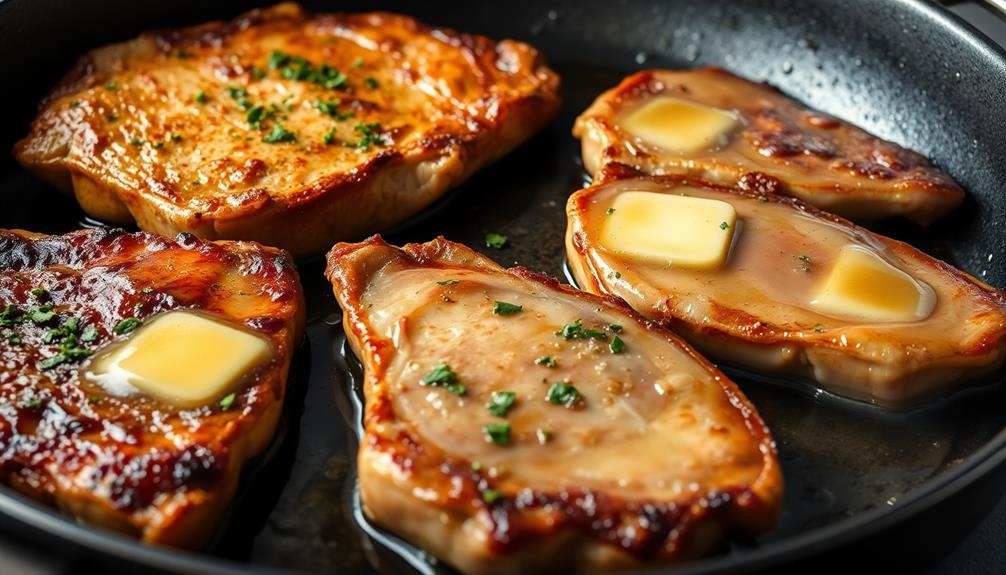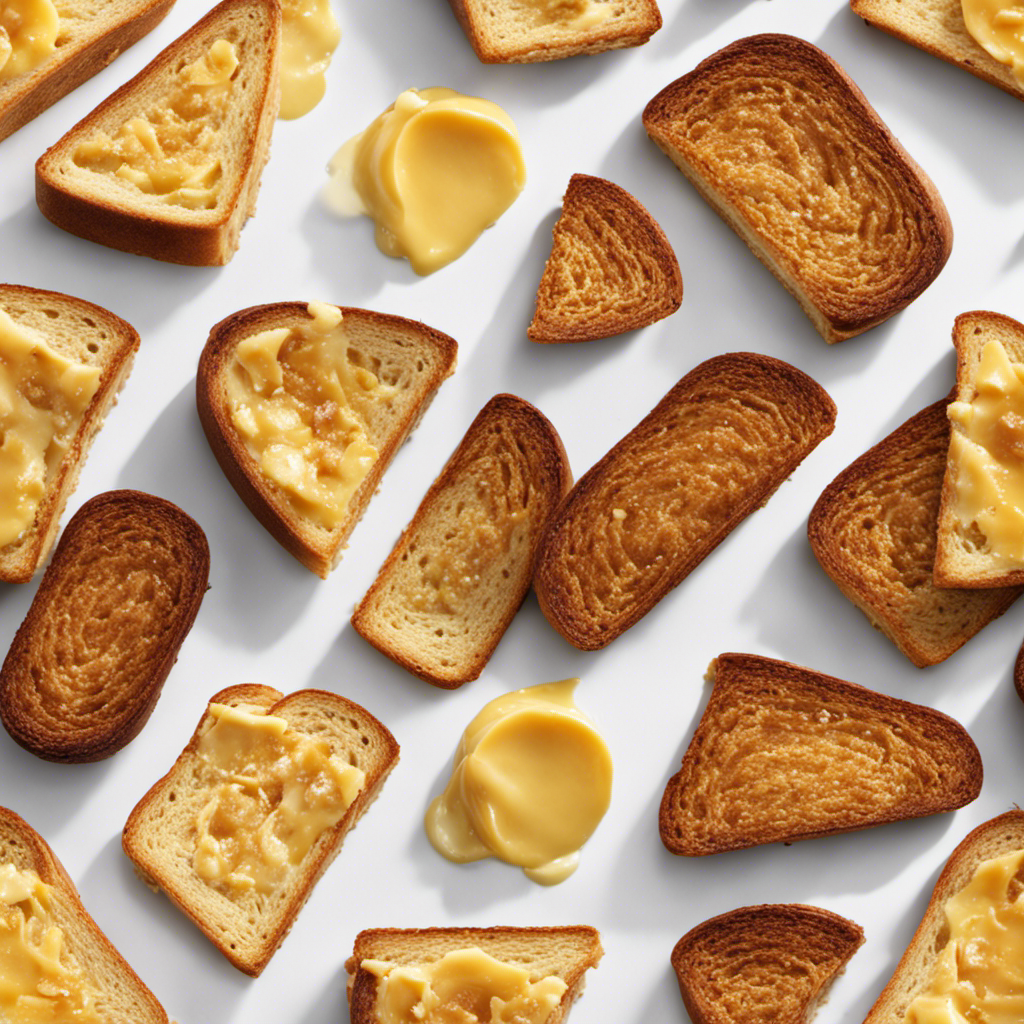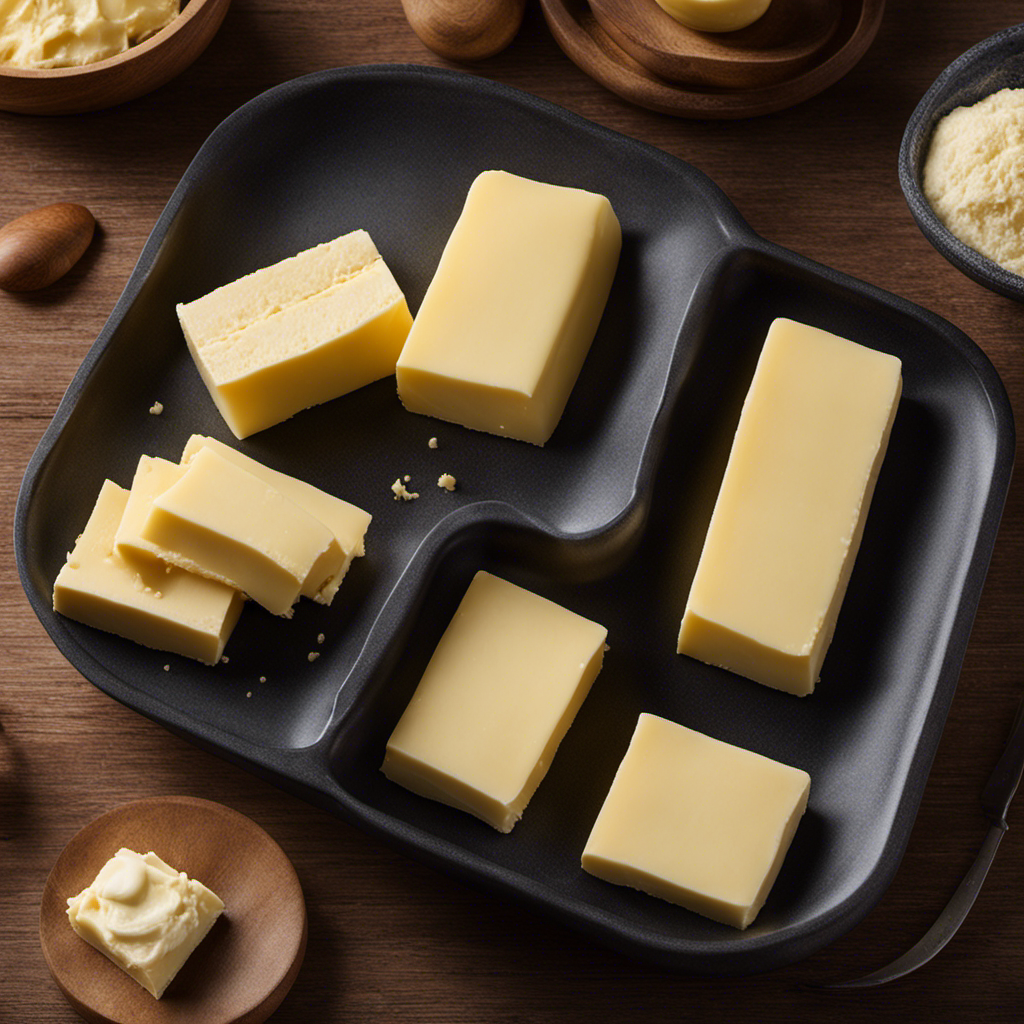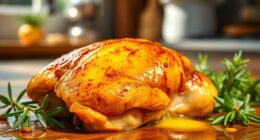I’ve often pondered the number of ounces contained in a stick of butter.
One day, I found myself in the kitchen, following a recipe that called for a stick of butter, but all I had was a tub of butter with no measurements.
It was frustrating not knowing exactly how much butter I needed.
That’s when I realized the importance of understanding the weight of a stick of butter in ounces.
In this article, we will explore different measurements for butter sticks and learn how to convert them accurately.
Key Takeaways
- A stick of butter typically measures 4 ounces.
- One stick of butter is equivalent to 8 tablespoons or half a cup.
- The weight of a single stick of butter is 4 ounces.
- Different countries may have different standard sizes for butter sticks.
Different Measurements for Butter Sticks
To clarify, did you know that a stick of butter typically measures 4 ounces?
However, if you find yourself in a situation where you don’t have a stick of butter on hand, there are alternatives you can use.
One substitute for a stick of butter is 8 tablespoons or half a cup. This measurement is equivalent to 4 ounces.
Another option is to use margarine, which can be used as a direct substitute for butter sticks in most recipes.
When it comes to baking, you can also use vegetable shortening as a replacement. It has a similar texture to butter and can be measured in the same way.
Understanding the Standard Stick of Butter
Understanding the standard stick of butter can be tricky, but it is important to know its measurement.
When it comes to different butter measurements, the stick is commonly used in recipes. A standard stick of butter is equal to 1/2 cup or 4 ounces. It is typically wrapped in a paper or foil package and is marked with tablespoon measurements to make it easier to use in cooking and baking.
However, if a recipe calls for a different measurement of butter, it is important to know how to convert it. For example, if a recipe calls for 1 cup of butter, you would need to use 2 sticks or 8 ounces.
Understanding these different butter measurements and how to convert them can help ensure the success of your culinary creations.
The Weight of a Single Stick of Butter
When it comes to baking or cooking, knowing the weight of a single stick of butter is essential. But have you ever wondered why the standard size of a stick of butter is 4 ounces?
In this discussion, we will explore the history behind the standard butter size and also delve into the different measurements of butter used worldwide. Get ready to butter up your knowledge!
Butter Stick Weight
Did you know that a stick of butter typically weighs 4 ounces? It’s a common measurement used in many recipes, but have you ever wondered about the different butter varieties and packaging options available?
Let’s take a closer look:
-
Salted butter: This is the most common butter variety, with a small amount of salt added for flavor and preservation.
-
Unsalted butter: As the name suggests, this variety doesn’t contain any added salt. It’s often preferred by those who want to control the salt content in their dishes.
-
Butter packaging options: Butter can be found in various packaging options, including foil-wrapped sticks, tubs, and blocks. Foil-wrapped sticks are convenient for measuring and can be easily stored in the refrigerator, while tubs and blocks are great for spreading on toast or using in larger quantities for baking.
Next time you’re at the grocery store, take a moment to explore the different butter varieties and packaging options available. You might just discover a new favorite!
Standard Butter Size
Take a moment to consider the typical size of a stick of butter and how it can vary depending on the brand and packaging. Different butter packaging can affect the weight of a stick. For example, some brands package their butter in rectangular blocks, while others use more traditional stick-shaped molds. This can result in variations in size and weight. Additionally, there are butter stick substitutes available for those who prefer a dairy-free or lower-fat option. These substitutes often come in similar packaging to regular butter sticks, making them a convenient alternative. To give you a better idea of the variations in butter packaging, here is a table showcasing the different sizes of butter sticks and their corresponding weights:
| Packaging | Weight (oz) |
|---|---|
| Rectangular Block | 8 |
| Stick-Shaped | 4 |
| Dairy-Free Substitute | 4 |
Whether you’re baking or spreading butter on your toast, understanding the different butter packaging options can help you make informed choices.
Butter Measurements Worldwide?
If you’re curious about butter measurements worldwide, you may be interested to know that different countries have varying methods of measuring butter. Here are some examples:
-
United States: In the US, butter is commonly sold in sticks, with each stick weighing 4 ounces or 113 grams. This makes it easy for bakers to measure and use in recipes.
-
United Kingdom: Across the pond, butter is typically sold in 250-gram blocks. This is equivalent to about 8.8 ounces or 2 sticks of butter in the US.
-
Australia: Down under, butter is usually sold in 250-gram blocks as well. However, the packaging may also include tablespoon measurements to make it easier for cooks to measure out the desired amount.
Knowing these butter measurements in cooking can come in handy when following recipes from different countries or converting measurements. So whether you’re baking in the US, UK, or Australia, you’ll now be equipped with the knowledge to measure your butter accurately.
Converting Sticks of Butter to Ounces
Converting sticks of butter to ounces is a simple process. When it comes to butter measurements, it’s important to know the weight of a standard stick of butter. In the United States, a stick of butter typically weighs 4 ounces. To convert the number of sticks of butter to ounces, you simply multiply the number of sticks by 4.
Here is a handy table to help you visualize the conversion:
| Number of Sticks | Ounces |
|---|---|
| 1 | 4 |
| 2 | 8 |
| 3 | 12 |
| 4 | 16 |
| 5 | 20 |
As you can see, each additional stick of butter adds 4 ounces to the total weight. Now that you know how to convert butter stick measurements to ounces, let’s explore how many ounces are in a half stick of butter.
How Many Ounces in a Half Stick of Butter
To find out how much a half stick of butter weighs, simply cut it in half. It’s as easy as that! But if you’re wondering how a half stick compares to a whole stick, here’s a breakdown:
- A whole stick of butter typically weighs 4 ounces or 113 grams.
- Therefore, a half stick of butter weighs about 2 ounces or 57 grams.
- This means that if a recipe calls for a whole stick of butter and you only have a half stick, you can simply use half of the weight or measure of the whole stick.
Now, what if you don’t have a half stick of butter? Don’t worry, there are alternatives! Here are some butter stick substitutes you can use:
- Margarine: Similar in texture and taste to butter, margarine can be used as a substitute in recipes.
- Coconut oil: This oil is a great dairy-free alternative and can be used in baking or cooking.
- Greek yogurt: For a healthier option, Greek yogurt can be used as a substitute in certain recipes.
Measuring Butter in Ounces: A Handy Guide
When measuring butter in ounces, you can easily determine the weight by using a kitchen scale. However, if you don’t have a scale, don’t worry! I’ve got you covered. Here’s a handy guide to help you measure butter in ounces, grams, and even convert those measurements to cups.
| Measurement | Ounces | Grams |
|---|---|---|
| 1 stick | 4 oz | 113 g |
| 1/2 stick | 2 oz | 57 g |
| 1/4 stick | 1 oz | 28 g |
Now, if you’re wondering how to convert these measurements to cups, let me break it down for you. One stick of butter is equal to half a cup or 8 tablespoons. So, if a recipe calls for 2 sticks of butter, you’ll need 1 cup or 16 tablespoons.
Understanding these measurements is essential for successful baking and cooking. In the next section, we’ll delve into the ounce-to-stick ratio so you can confidently tackle any recipe that calls for butter.
Breaking Down the Ounce-to-Stick Ratio
So you’ve mastered measuring butter in ounces, but what about when a recipe calls for a stick of butter? Don’t worry, I’ve got you covered.
In this discussion, we’ll delve into the ounce-to-stick ratio, making it easier for you to convert butter measurements and understand the standard stick size.
Let’s break it down and take the guesswork out of using butter in your recipes.
Butter Measurement Conversions
Did you know that a stick of butter is typically equivalent to 4 ounces? Understanding butter measurement equivalents can be useful when following recipes or making substitutions.
Here are three common conversions to help you navigate the world of butter measurements:
-
1 stick of butter = 4 ounces = 1/2 cup = 8 tablespoons
-
1/2 stick of butter = 2 ounces = 1/4 cup = 4 tablespoons
-
1/4 stick of butter = 1 ounce = 2 tablespoons
Converting butter measurements is essential for achieving accurate results in baking and cooking. Whether you need to halve a recipe or adjust the amount of butter needed, having a grasp of these conversions will make your culinary endeavors much easier.
Standard Stick Size
Now that we know how to convert butter measurements, let’s talk about the standard stick size.
In the United States, a stick of butter typically measures 1/2 cup or 8 tablespoons, which is equivalent to 4 ounces or 113 grams. This is the most common size you’ll find in American recipes.
However, it’s important to note that butter stick sizes can vary internationally. In some countries, like Australia and New Zealand, the standard size is 250 grams, while in the United Kingdom, it’s 227 grams.
Calculating Sticks of Butter in Recipes
To calculate the number of sticks of butter needed for a recipe, you can divide the total ounces by 4. This is a simple and convenient way to determine the amount of butter required in any given recipe.
Here are three key points to keep in mind when calculating sticks of butter:
-
Understanding butter substitutions: If a recipe calls for a certain number of sticks of butter, but you don’t have enough, you can easily substitute with other ingredients. For example, you can use margarine or vegetable shortening as a replacement.
-
The history of butter measurements: The stick of butter as we know it today originated in the United States in the early 20th century. It was created to make it easier for consumers to measure and use butter in their recipes.
-
The importance of accuracy: When measuring butter, it’s important to be precise. Using the correct amount can greatly affect the texture and taste of your baked goods. So, always make sure to measure carefully and follow the recipe instructions accordingly.
Adjusting Butter Measurements for Baking
When it comes to baking, butter plays a crucial role in achieving the perfect texture and flavor. In this discussion, we will explore some helpful tips for converting butter measurements and ensuring accurate measurements when baking.
We will also discuss how to effectively incorporate butter into your recipes. Whether you’re a novice baker or a seasoned pro, these insights will help you navigate the world of butter in baking with confidence and delicious results.
Butter Conversion Tips
Did you know that a stick of butter is typically equivalent to 4 ounces?
When it comes to different butter brands, it’s important to note that the weight of a stick may vary slightly. Some brands might have sticks that weigh 3.5 ounces, while others may have sticks that weigh 4.25 ounces. So, it’s always a good idea to check the packaging for the exact weight.
When it comes to butter substitutes, there are several options available, such as margarine, coconut oil, or applesauce. However, keep in mind that these substitutes might affect the texture and flavor of your baked goods.
Now that we know about butter conversions and substitutes, let’s explore the world of baking with butter.
Baking With Butter
Using butter in baking adds richness and moisture to your favorite recipes. It’s a versatile ingredient that can enhance the flavor and texture of pastries, cakes, and cookies. When it comes to measuring butter for pastry, it’s important to know that a stick of butter typically weighs 4 ounces or 113 grams. This information is crucial for achieving accurate and consistent results in your baking. However, if you’re looking for butter substitutes for baking, there are a few options to consider. Margarine, shortening, and coconut oil can all be used as substitutes for butter in certain recipes. Each has its own unique qualities and may affect the final outcome of your baked goods. Experimenting with different substitutes can lead to delicious and unexpected results in your baking adventures. So go ahead, get creative, and enjoy the wonderful world of baking with butter.
| Butter | Weight (oz) | Weight (g) |
|---|---|---|
| Stick | 4 | 113 |
| Cup | 8 | 226 |
| Tablespoon | 0.5 | 14 |
| Teaspoon | 0.17 | 5 |
Measuring Butter Accurately
To achieve accurate results in baking, it’s crucial to know the weight of a stick of butter. However, sometimes we may need to use butter alternatives or substitutes in our recipes. Here’s how you can measure them accurately:
-
Read the label: Butter alternatives come in various forms like margarine or shortening. Check the packaging for the weight equivalent of one stick of butter. This information will guide you in measuring the right amount.
-
Use a kitchen scale: To ensure precise measurements, invest in a digital kitchen scale. Place your butter alternative on the scale and measure the required weight according to the recipe.
-
Conversion chart: If you don’t have a kitchen scale, consult a conversion chart that provides the weight equivalents for different butter substitutes. This will help you make accurate measurements without a scale.
Converting Ounces to Sticks of Butter
You can easily convert ounces to sticks of butter by dividing the number of ounces by 4.
When it comes to measuring butter, there are different measurements used, and understanding how to convert between them can be helpful in the kitchen.
A stick of butter is a common measurement used in many recipes, but sometimes you may come across a recipe that calls for ounces instead. To convert ounces to sticks of butter, simply divide the number of ounces by 4.
For example, if a recipe calls for 8 ounces of butter, you would divide 8 by 4 to get 2 sticks of butter. This conversion can be quite handy when you want to ensure you have the right amount of butter for your recipe.
The Butter Stick Conversion Chart
In my previous explanation, I discussed how to convert ounces to sticks of butter. Now, let’s delve into the Butter Stick Conversion Chart, which provides a handy reference for converting butter measurements.
This chart is incredibly useful when you come across a recipe that uses butter sticks instead of ounces. Here are three butter stick equivalents commonly used in recipes:
- One stick of butter is equal to 8 tablespoons or 1/2 cup.
- Two sticks of butter are equivalent to 16 tablespoons or 1 cup.
- Four sticks of butter make up a pound, which is equal to 32 tablespoons or 2 cups.
By referring to this chart, you can easily convert butter measurements and ensure your recipe turns out just right.
Happy baking!
Common Mistakes in Measuring Butter
When measuring butter, it’s important to avoid making these common mistakes. One of the most common errors is not using the correct measuring tool. Many people try to measure butter with a liquid measuring cup, which can lead to inaccurate results.
Another common misconception is not softening the butter properly before measuring. Softened butter should be at room temperature, not melted or too cold, for accurate measurements.
Additionally, eyeballing the amount of butter instead of actually measuring it can result in inconsistent results. These common errors can lead to recipes turning out differently than expected.
To ensure accurate butter measurements, it’s important to follow some tips and tricks that will be discussed in the next section.
Tips and Tricks for Accurate Butter Measurements
To ensure accurate measurements of butter, it’s important to follow these tips and tricks:
-
Use a kitchen scale: Weighing the butter will give you the most precise measurement. One stick of butter is typically equal to 4 ounces or 113 grams.
-
Use measurement markings on the wrapper: Many butter wrappers have markings to indicate tablespoons or cups, making it easy to measure without a scale.
-
Know the butter measurement equivalents: If a recipe calls for a certain amount of butter, it’s helpful to know the equivalents. One stick of butter is equal to half a cup or 8 tablespoons.
When it comes to using butter substitutes, keep in mind that they may have different measurements and consistencies. It’s best to follow the specific instructions provided by the manufacturer for accurate results.
Frequently Asked Questions
Can I Use Margarine Instead of Butter in Recipes?
Yes, margarine can be used instead of butter in recipes. However, keep in mind that margarine may have a slightly different taste compared to butter. It also offers some health benefits, such as being lower in saturated fat.
How Many Tablespoons Are in a Stick of Butter?
When baking, it’s important to know how much butter to use. One stick of butter is equivalent to 8 tablespoons. If your butter is too hard, you can quickly soften it by microwaving it for a few seconds.
How Should I Store Butter to Keep It Fresh?
To extend the shelf life of butter, store it in an airtight container in the refrigerator. Avoid exposure to light and strong odors. Just like a delicate flower, proper care will keep your butter fresh and ready to spread.
Can I Use Salted Butter Instead of Unsalted Butter in Baking?
Yes, you can use salted butter instead of unsalted butter in baking. The main difference is the added salt in salted butter, which can affect the taste of your baked goods. Adjust the salt in your recipe accordingly.
Is It Possible to Substitute Oil for Butter in Recipes?
Substituting butter with vegetable oil in recipes is possible. It’s like swapping a cozy sweater for a lightweight t-shirt. The pros include a healthier option, while the cons are a potential change in flavor and texture. Other alternatives for butter in baking recipes include applesauce and Greek yogurt.
Conclusion
Well, folks, we’ve reached the end of our buttery journey. Who knew that a simple stick of butter could be so complicated? But fear not, for now you are armed with knowledge on how to measure butter like a pro.
No longer will you be clueless when a recipe calls for ‘sticks’ or ‘ounces’ of butter. So, go forth and conquer the world of buttery delights, my friends. And remember, in the quest for culinary perfection, every ounce of butter counts!
